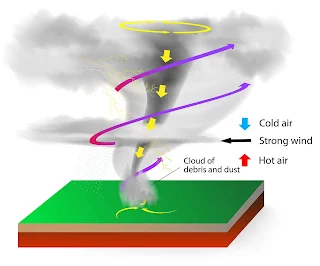What is a Tornado? How is it formed and what are the effects of tornadoes?
 |
| Formation of Tornado |
A tornado is a rapidly
rotating column of air that extends from a thunderstorm cloud to the ground. It
is one of the most destructive and dangerous weather phenomena on Earth.
Tornadoes are capable of inflicting severe damage to structures and landscapes
and can pose a significant threat to human life.
Formation of Tornadoes:
Tornadoes are formed under specific meteorological conditions, typically during severe thunderstorms. The process of tornado formation involves the following steps:
- Ingredients:
For a tornado to form, you need warm, moist air from the surface and cold,
dry air from aloft. The boundary where these two air masses meet is called
a "dryline." Additionally, wind shear is essential, meaning that
wind speed and direction change with height in the atmosphere.
- Updraft: During a severe
thunderstorm, strong updrafts of warm, moist air rise rapidly from the
ground. These updrafts create a rotating horizontal column of air.
- Tilt and Rotation:
As the storm's updraft tilts the rotating air vertically, it begins to
form a spinning cylinder, called a "mesocyclone."
- Tornado Funnel:
If the mesocyclone becomes intense enough, it can extend downward and form
a visible funnel cloud. When the funnel cloud touches the ground, it
officially becomes a tornado.
Effects of Tornadoes:
Tornadoes can have devastating
effects on the areas they impact. The severity of the damage depends on factors
like tornado strength, size, path, and the density of human infrastructure in
the affected region. Some of the effects of tornadoes include:
- Structural Damage:
Tornadoes can level buildings, houses, and other structures. High-end
tornadoes with wind speeds exceeding 200 mph (320 km/h) can obliterate
well-built structures, leaving only debris behind.
- Debris Propagation:
Tornadoes hurl debris at high velocities, turning everyday objects into
dangerous projectiles. This flying debris can cause additional damage and
pose a significant risk to people caught in the tornado's path.
- Loss of Life and Injuries:
Tornadoes can cause fatalities and injuries to those in their path. The
powerful winds can trap people, collapse structures, and cause blunt-force
trauma.
- Environmental Impact:
Tornadoes can uproot trees, strip vegetation, and destroy natural
habitats, impacting wildlife and ecosystems.
- Economic Impact:
The destruction caused by tornadoes can lead to significant economic
losses for affected communities. Rebuilding infrastructure and homes,
along with other recovery efforts, can be costly.
- Psychological Impact:
Tornadoes and their aftermath can lead to emotional and psychological
trauma for survivors, witnesses, and rescue workers.
It's important to note that
tornadoes can be detected and monitored using radar systems and weather
satellites, allowing for advance warnings and the issuance of tornado watches
and warnings to help people prepare and seek shelter in the event of an
approaching tornado. Taking these warnings seriously and following safety
protocols can save lives during tornado events.
